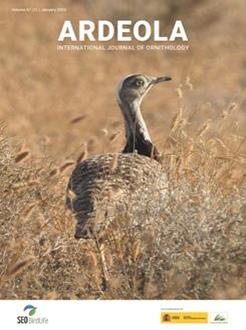The migration of Siberian passerines is little known, although the number of studies has been increasing recently. However, due to the lack of recoveries of ringed individuals along the East Asian migratory flyway, and the size-dependent limitation on the use of geolocators, studies of the migration routes of small leaf-warblers are scarce. The only promising method is flight range estimation by using biometric parameters to identify migration distances and locate possible stopover sites along the flyway. The aim of this study was to estimate the flight ranges of migrant Radde's warblers Phylloscopus schwarzi, Dusky Warblers P. fuscatus and Pallas's Leaf-warblers P. proregulus at a stopover site next to Lake Baikal, Russia. For the analyses, we used the body mass, fat score and wing-length data of 809 individuals, which were trapped with mist-nets during the autumn migration periods between 2012 and 2017. Our results show that body mass, but not wing length, increased significantly among individuals with increasing fat scores in all study species. The estimated flight ranges of Pallas's Leaf-warbler (724km) and Radde's Warbler (510km) were similar to those of birds studied in a different part of Siberia, and the number of calculated stopovers was also similar between the two areas. In contrast, Dusky Warblers trapped at our study site were estimated to fly shorter distances (217km) and therefore must have stopped more frequently on their way to the wintering grounds.—Bozó, L., Csörgő, T. & Anisimov, Y. (2020). Estimation of flight range of migrant leaf-warblers at Lake Baikal. Ardeola, 67: 57-67.
La migración de paseriformes siberianos se conoce poco, aunque el número de estudios se ha incrementado recientemente. No obstante, debido a la ausencia de recuperaciones de ejemplares anillados a lo largo de la ruta migratoria del este de Asia, y a la limitación debida al tamaño para el uso de geolocalizadores, los estudios de las rutas de migración de pequeños mosquiteros son escasos. El único método prometedor es la estimación de las distancias de vuelo usando parámetros biológicos para identificar las distancias de migración y localizar posibles escalas a lo largo de la ruta. El objetivo de este estudio fue estimar las distancias de vuelo de los migradores mosquitero de Schwarz Phylloscopus schwarzi, mosquitero sombrío P. fuscatus y mosquitero de Pallas P. proregulus en una escala de migración adyacente al lago Baikal, Rusia. Se usaron para los análisis el peso corporal, el índice de grasa y la longitud del ala de 809 individuos capturados con redes japonesas durante los periodos de migración otoñal entre 2012 y 2017. Nuestros resultados muestran que el peso corporal, pero no la longitud del ala, se incrementó significativamente entre los individuos de acuerdo a los índices de grasa en todas las especies de estudio. Las distancias estimadas de vuelo del mosquitero de Pallas (724 km) y del mosquitero de Schwarz (510 km), así como el número de escalas que se calculan para estas especies, fueron similares a las que se han encontrado en otras partes de Siberia. En cambio, se estimó que los mosquiteros sombríos capturados en nuestra área de estudio tenían menores distancias de vuelo (217 km) y por tanto deberían parar más frecuentemente en su ruta hacia sus áreas de invernada.—Bozó, L., Csörgő, T. y Anisimov, Y. (2020). Estima de la distancia de vuelo de mosquiteros migradores en el lago Baikal. Ardeola, 67: 57-67.





